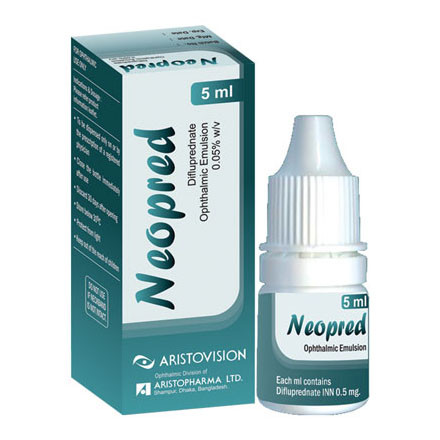5 ml drop:
৳ 230.00
Indications
Neopred is indicated for the treatment of inflammation and pain associated with ocular surgery. It is also indicated for the treatment of uveitis, pseudophakic cystoid macular edema(CME), ocular surface diseases, e.g. blepharitis & corneal inflammation.
Pharmacology
Corticosteroids inhibit the inflammatory response to a variety of inciting agents and may delay or slow healing. They inhibit edema, fibrin deposition, capillary dilation, leukocyte migration, capillary proliferation, fibroblast proliferation, deposition of collagen, and scar formation associated with inflammation. There is no generally accepted explanation for the mechanism of action of ocular corticosteroids. However, corticosteroids are thought to act by the induction of phospholipase A2 inhibitory proteins, collectively called lipocortins. It is postulated that these proteins control the biosynthesis of potent mediators of inflammation such as prostaglandins and leukotrienes by inhibiting the release of their common precursor arachidonic acid. Arachidonic acid is released from membrane phospholipids by phospholipase A2. Difluprednate is structurally similar to other corticosteroids.
Dosage & Administration
For the treatment of inflammation and pain associated with ocular surgery: Instill 1 drop into the conjunctival sac of the affected eye 4 times daily beginning 24 hours after surgery and continuing throughout the first 2 weeks of the post-operative period, followed by 2 times daily for a week and then a taper based on the response.
For the treatment of endogenous anterior uveitis: Instill 1 drop into the conjunctival sac of the affected eye 4 times daily for 14 days followed by tapering as clinically indicated.
For blepharitis: Instill 1 drop into the conjunctival sac of the affected eyes 2 times daily for 1 week & then once daily for 1 week.
For pseudophakic cystoid macular edema: Instill 1 drop into the conjunctival sac of the affected eyes 2 times daily.
For the treatment of endogenous anterior uveitis: Instill 1 drop into the conjunctival sac of the affected eye 4 times daily for 14 days followed by tapering as clinically indicated.
For blepharitis: Instill 1 drop into the conjunctival sac of the affected eyes 2 times daily for 1 week & then once daily for 1 week.
For pseudophakic cystoid macular edema: Instill 1 drop into the conjunctival sac of the affected eyes 2 times daily.
Interaction
Specific drug interaction studies have not been conducted with Neopred 0.05% ophthalmic emulsion.
Contraindications
Difluprednate is contraindicated in most active viral diseases of the cornea and conjunctiva including epithelial herpes simplex keratitis (dendritic keratitis), vaccinia, and varicella, and also in mycobacterial infection of the eye and fungal diseases of ocular structures.
Side Effects
Adverse reactions associated with ophthalmic steroids include elevated intraocular pressure, which may be associated with optic nerve damage, visual acuity and field defects; posterior subcapsular cataract formation; secondary ocular infection from pathogens including herpes simplex, and perforation of the globe where there is thinning of the cornea or sclera. Ocular adverse reactions occurring with Neopred included corneal edema, ciliary and conjunctival hyperemia, eye pain, photophobia, posterior capsule opacification, anterior chamber cells, anterior chamber flare, conjunctival edema, and blepharitis for patient with ocular surgery.
Pregnancy & Lactation
Pregnancy Category C. Difluprednate has been shown to be embryotoxic and teratogenic when administered subcutaneously to rabbits. Since use of Difluprednate during human pregnancy has not been evaluated so Difluprednate should be used during pregnancy only if the potential benefit justifies the potential risk to the embryo or fetus. It is not known whether use of Difluprednate passes into breast milk. Caution should be exercised when it is administered to a nursing mothers.
Precautions & Warnings
- Prolonged use of corticosteroids may result in glaucoma & posterior subcapsular cataract formation. If Neopred is used for 10 days or longer, IOP should be monitored.
- Use of a corticosteroid medication in the treatment of patients with a history of herpes simplex requires great caution.
- Fungal infections of the cornea are particularly prone to develop coincidentally with long-term local steroid application.
- Do not touch dropper tip to any surface as this may contaminate Neopred.
Use in Special Populations
Pediatric Use: Neopred was evaluated in 0 to 3 years of age for the treatment of inflammation following cataract surgery. A similar safety profile was observed in pediatric patients comparing Neopred to Prednisolone Acetate ophthalmic suspension 1%.
Geriatric Use: No overall differences in safety or effectiveness have been observed between elderly and younger patients.
Geriatric Use: No overall differences in safety or effectiveness have been observed between elderly and younger patients.
Overdose Effects
Overdosage will not ordinarily cause acute problems. If accidentally ingested, drink fluids to dilute.
Therapeutic Class
Ophthalmic Steroid preparations
Storage Conditions
Store at room temperature, protect from light and freezing. It is desirable that the contents should not be used more than 1 month after first opening of the bottle.
Pack Images: Neopred 0.05% Eye Drop



